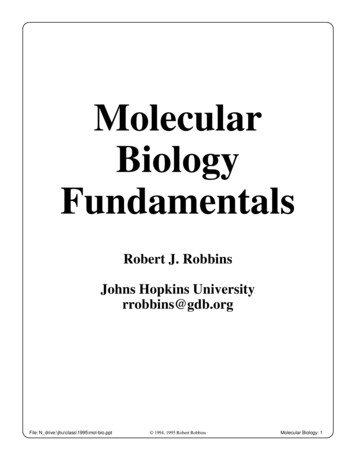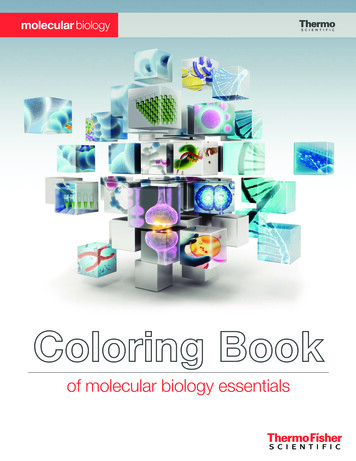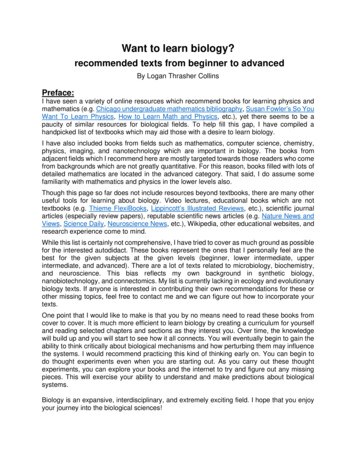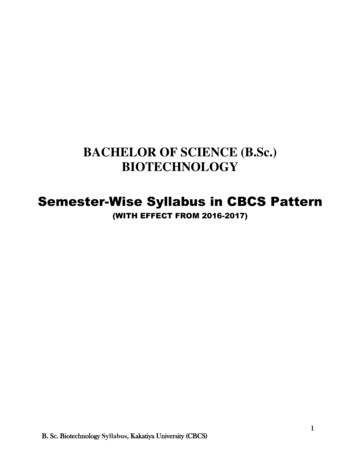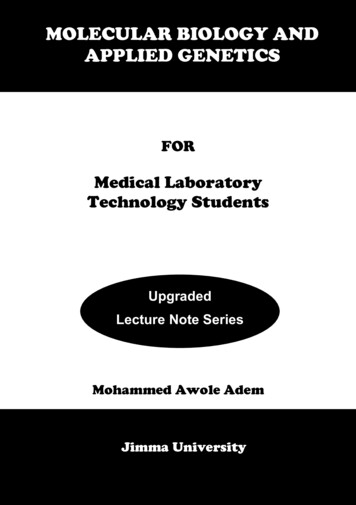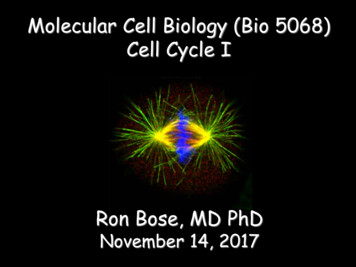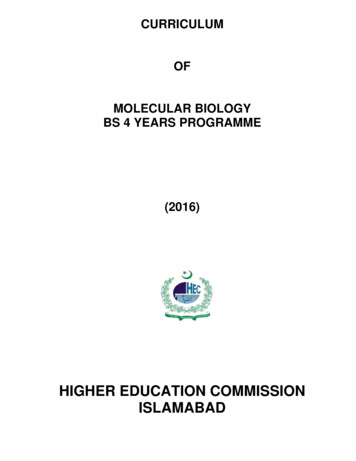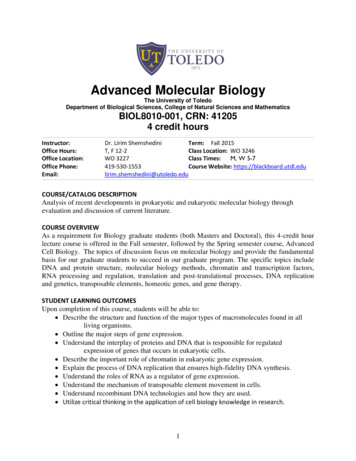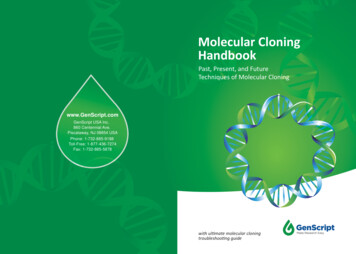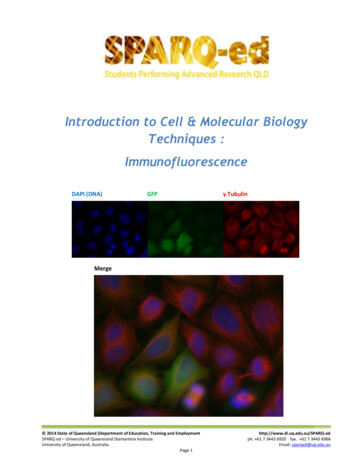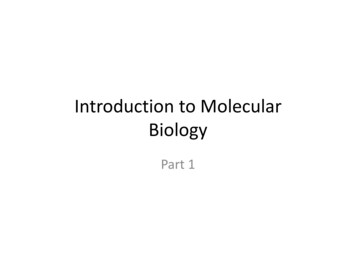
Transcription
Introduction to MolecularBiologyPart 1
Discovery of cells Microscopic biology began in 1665 Robert Hooke (1635‐1703) discoveredorganisms are made up of cells2
Cells Fundamental working units of all living systems Every organism is composed of one or twodifferent types of cells– Prokaryotic cells– Eukaryotic cells Prokaryotes and Eukaryotes are descendedfrom the same primitive cell All extant cells are the result of 3.5 billionyears of evolution3
Cells4
Cells A cell is a smallest structural unit of an organism thatis capable of independent functioning All cells have some common features5
Cell Cycles: Born, Eat, Replicate, Die6
Cell: Contents Chemical Composition (by weight)– 70% water– 7% small molecules Salts, lipids, amino acids, nucleotides– 23% macromolecules Proteins, polysaccharides, lipids Biochemical (Metabolic) Pathways Translation of mRNA into Proteins7
Cells: Prokaryotes & Eukaryotes8
Prokaryotes & Eukaryotes9
Charles Darwin: Tree of Life“I think case must be thatone generation should haveas many living as now. To dothis and to have as manyspecies in same genus (as is)requires extinction . Thusbetween A B the immensegap of relation. C B thefinest gradation. B D rathergreater distinction. Thusgenera would be formed.Bearing relation" (next pagebegins) "to ancient typeswith several extinct forms”‐: Charles Darwin, 183710
Prokaryotes & EukaryotesProkaryotesEukaryotes Single Cell Single or multi cell No nucleus Nucleus No organelles Organnelles One piece of Circular DNA Chromosomes No mRNA post‐transcriptionalmodification Exons/Introns splicing11
Prokaryotes & EukaryotesStructural DifferencesProkaryotesEukaryotes Eubacteria (blue green algae)and archaebacteria Plants, animals, Protista, fungi Only one type of membranePlasma membrane forms theboundary of the cell Complex systems of internalmembranes forms organelle andcompartments The smallest cells known arebacteria (E. Coli cell,3 10 protein molecules,1000‐2000 polypeptide species) Volume of cell is several hundredtimes larger (Hela cell, 5 10protein molecules,5000‐10000 polypeptide species12
Prokaryotes & EukaryotesChromosomal DifferencesProkaryotesEukatryotes The genome of E. Coli contains4 10 base pairs The genome of yeast contains1.35 10 base pairs 90% of DNA encode protein A small fraction of the DNA encodesprotein (many repeats of non‐coding sequences) Lacks a membrane bound nucleus All chromosomes are contained inCircular DNAa membrane bound nucleusand supercoiled domain(DNA is divided between one ormore chromosomes) Histones are unknown A set of five histonesDNA packaging and geneexpression regulation13
Signaling Pathways Control GeneActivity Instead of having brains, cells make decisionsthrough complex networks of chemicalreactions, called pathways– Synthesize new materials– Break other materials down for spare parts– Signal to eat or die14
Cells: Information & Machinery Cells store all information to replicate– Human genome is aroundbase pairs long– Almost every cell in a human body contains same setof genes– But not all genes are used/expressed by all cells Machinery– Collect and manufacture components– Carry out replication– Kick‐start its new offspring(A cell is like a car factory!)15
The Human Genome Project 1986 Leroy Hood: Developed automatedsequencing mechanism 1986 Human Genome Initiative announced 1990 The 15 year Human Genome project islaunched by congress 1995 John Craig Venter: First bactierial genomessequenced 1997 E. Coli sequenced 1996 First eukaryotic genome‐yeast‐sequenced16
The Human Genome Project 2000 J. Craig Ventnor (Celera)and Francis Collins (IHGSC)announce sequencing thecomplete human genome 2001 International HumanGenome Sequencing: Firstdraft of the sequence of thehuman genome published False start until 200317
Organization of Life: OverviewNucleus libraryChromosomes bookshelvesGenes booksAlmost every cell in an organism contains thesame libraries and the same set of books Books represent all the information (DNA) thatevery cell in the body needs so it can growand carry out its various functions 18
Terminology Genome: An organism’s genetic material Gene: Discrete unit of hereditary information locatedon the chromosomes and consisting of DNA Genotype: The genetic makeup of an organism Phenotype: The physical expressed traits of anorganism Nucleic Acid: Biological molecules (DNA & RNA) thatallow organisms to reproduce19
Genotype & Phenotype Genes are inherited and areexpressed– genotype (genetic makeup)– phenotype (physicalexpression) On the left, is the eye’sphenotypes of green and blackeye genes.20
Genotype & Phenotype Genes are like recipes (genotype) Think of a recipe for a cake Only partly guarantee the end result (phenotype) Environment plays a crucial role21
Terminology The genome is an organism’s complete DNA.A bacteria contains about 600,000 DNA base pairsHuman and mouse genomes have 3 billion base pairs. Human genome has 24 distinct chromosomes.Each chromosome contains many genes. Genes are the basic functional units of heredity.Specific sequences of DNA bases that encodeinstructions on how to make proteins. Proteins make up the cellular structure.Large complex molecules made up of smaller subunitscalled amino acids.22
Life: 3 Critical Molecules DNAHolds information on how cell works RNAActs to transfer short pieces of information to different parts of a cellProvides templates to synthesize proteins ProteinsForm enzymes that send signals to other cells and regulate gene activityForm body’s major components (e.g. hair, skin, etc.)23
DNA: The Double Helix 1952‐1953 James D. Watson and Francis H. C.Crick deduced the double helical structure ofDNA24
DNA: The Code of Life The structure and the four genomic letters code forall living organisms Adenine, Guanine, Thymine, and Cytosine which pairA‐T and C‐G on complimentary strands.25
DNA: The Code of Life DNA has a double helixstructure whichcomposed of– sugar molecule– phosphate group– and a base (A,C,G,T) DNA always reads from 5’end to 3’ end fortranscription replication5’ ATTTAGGCC 3’3’ TAAATCCGG 5’26
DNA &RNA: Flow of InformationReplicationTranscriptionTranslation27
DNA & RNA: Flow of InformationReplicationTranscriptionTranslationaka “The Central Dogma”!!28
Francis Crick“The central dogma ofmolecular biology dealswith the detailed residue‐by‐residue transfer ofsequential information. Itstates that suchinformation cannot betransferred from proteinto either protein ofnucleic acid.”‐: Francis Crick, Central Dogma of Molecular Biology,Nature, Volume 227, August 1970.29
DNA to RNA to ProteinA gene is expressed in two steps1. Transcription: RNA Synthesis2. Translation: Protein Synthesis30
The Code Book DNA, RNA, andProteins are examplesof strings written ineither the four‐letternucleotide of DNA andRNA (A C G T/U) or the twenty‐letteramino acid ofproteins. Each aminoacid is coded by 3nucleotides calledcodons31
32Sheldon’s Favorite Amino Acid
The Code Book33
DNA & RNA DNA Deoxyribonucleic acidRNA Ribonucleic acidThey are almost the same There is no T base in RNAA similar base U takes its placeAn oxygen atom is added to the sugarcomponent of RNA34
References Neil C. Jones and Pavel A. Pevzner, AnIntroduction to Bioinformatics Algorithms, MITPress 2004. Adapted from slides posted at the web site ofthe above book. Francis Crick, Central Dogma of MolecularBiology, Nature, Volume 227, August 1970. Luciano Floridi, Information: A Very ShortIntroduction, Oxford 2010.35
molecular biology deals with the detailed residue‐ by‐residue transfer of sequential information. It states that such information cannot be transferred from protein to either protein of nucleic acid.” ‐: Francis Crick, Central Dogma of Molecu
